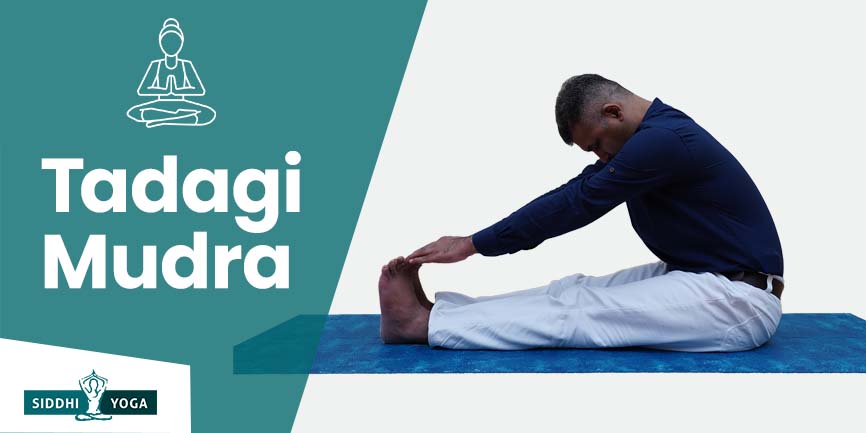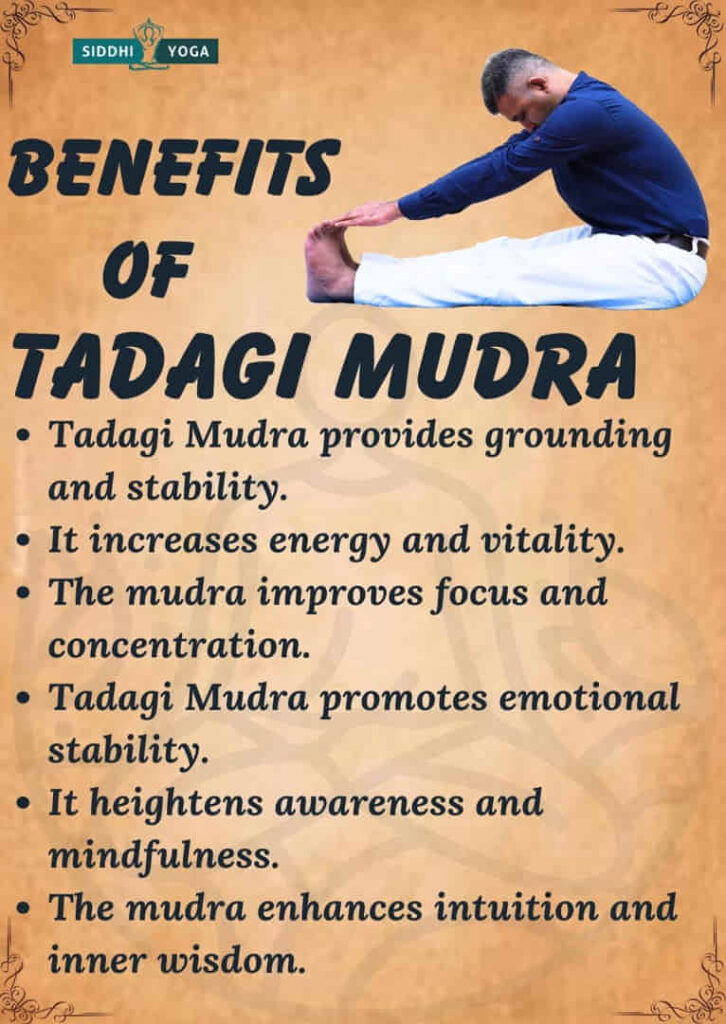
What is the Tadagi Mudra, and what are its benefits? This article explores the meaning, benefits, and how to do Tadagi Mudra.
Definition – What is Tadagi Mudra and its Meaning, References, and Mythology?
Tadagi Mudra is one of the Postural Mudras, otherwise known as Kaya Mudra. To simplify the meaning of this Mudra, let us break it down into two different words and then understand its meaning.
Tadagi – “Tadagi” is made of the Sanskrit word “Tadaga” which means a lake or pond.
Mudra – The Sanskrit word “Mudra” is used to describe Kaya Mudra.
While practicing this Pose/Mudra, our stomach assumes a similar shape to that of a pond or a lake; hence it was named after it. This Mudra is also named Pond seal or The gesture of pond/lake.
Tadagi Mudra is often assumed when practicing a forward bending posture, such as Paschimottansana (Seated Forward Fold) and Janu-Sirasana. This Mudra helps to stretch the various muscle groups, such as the hamstrings muscles, which are located in the rear thighs. Since many people have tight hamstrings, which can cause disharmony with the other leg muscles, practicing this Mudra helps to harmonize their balance.
Many of us might be familiar with the name diaphragm. It is a muscle that separates the abdominal cavity from the thoracic cavity, or in other words. It separates the respiratory system from the digestive system. When we assume this, Mudra helps to relieve all the tension that is kept around the diaphragm muscle. It is also believed that it helps relieve stress hidden around the diaphragm and pelvic muscles. Better diaphragm muscle means better respiratory system response and better digestive system response.
This Mudra practice also stimulates the digestive organs, so it can improve digestion as well but make sure to practice it empty stomach. This Mudra also improves pranic flow by stimulating the Manipura Chakra.
This is one of the Mudras which is believed to prevent aging. It is believed that if someone practices this Mudra, he or she can prevent his/her body from aging. By this, we mean that it makes the aging process slow. It is believed that it also keeps you skin-tight and keeps it hydrated.
Alternate Names of Tadagi Mudra
Pond seal, the gesture of pond/lake.
How to Do Tadagi Mudra?
- This Mudra is one of the Kaya Mudras or Postural Mudras, which involves assuming bodily Postures.
- You can practice it by first sitting in any comfortable posture, then slowly start extending both of your legs. Bring them close to each other while maintaining a small gap.
- Take a deep breath in and bring your hands on your knees.
- Now, start to exhale, bend forward, and try to catch your big toe with your fingers.
- Gaze towards the toes.
- Now, take a deep inhalation and let the stomach expand maximum out.
- Retain the breath for a comfortable period without getting any sense of discomfort.
- Exhale slowly and relax your stomach and the entire body.
- Practice it 10-12 more times.
Tadagi Mudra Benefits

- Practicing this Mudra helps to release the tension from the diaphragm muscle, which separates the digestive system from the respiratory system. This, in turn, helps improve the digestive and respiratory systems.
- This Mudra also helps to release the tension from the pelvic region.
- It helps to stretch the hamstrings muscles. However, the Sulabh Tadagi Mudra is an exception to this.
- This Mudra increase Pranic energy in the body by stimulating the Manipura Chakra.
- This Mudra helps to tone up the stomach region.
- It is also believed that practicing this Mudra can delay the aging process.
- This Mudra can help to reduce fat.
Tadagi Mudra Precautions and Contraindications

Similar to all other Mudra practices, it has no side effects.
However, there are a few things to consider:
- Have patients if you want to achieve a good result.
- If you are dealing with spine-related issues, we recommend practicing it under the guidance of a qualified teacher. However, Sulabh Tadagi Mudra can be practiced in cases where we keep the spine close to the floor.
- Make sure you do not experience any pain while practicing this, Mudra.
- It shouldn’t be practiced during pregnancy.
- Make sure not to strain yourself while retaining your breath.
When and how long to do Tadagi Mudra?
- This Mudra can be practiced to improve your diaphragm muscle functioning.
- If you have pelvic muscle-related issues, then it will help.
- You can practice this to improve your digestive and respiratory systems.
Morning is the ideal time to do any yoga or Mudra. Our brain is at its best in the morning and during the daytime. So, you are more likely to be able to concentrate easily. Therefore, you should practice this Mudra from 4 am and 6 am to get the most effective outcomes.
If you are having difficulty with this during the morning, you can do this Mudra later in the evening too.
Based on research, the best way to practice an exercise for at least 10-20 minutes is to get the best benefits of that particular Mudra. Practicing this Mudra for a minimum of 3-5 times daily is recommended. It’s up to you whether you wish to complete it in one stretch or in two threes that last between 1 to 5 minutes.
Breathing in Tadagi Mudra
There are different types of breathing we can practice with this Mudra. You can start with:
- Abdominal Breathing, where you expand the stomach maximum out with inhalation and relax your stomach with exhalation. For 10-12 times in a single go.
- If you have been an intermediate or expert practitioner or practitioner for a long time, then you can aim for a 1:2 ratio of inhalation to exhalation.
Affirmation in Tadagi Mudra
While practicing this, Keep a positive intention. Start with:
“Nature has many things to offer. It nurtures me. I will not disharmonize the natural things in my life.”
Conclusion
The Tadagi Mudra is a great mudra to use for those who are new to the practice. It has many benefits and can be done by anyone, no matter their level of experience. If you’re interested in learning more about mudras and how to incorporate them into your life, we recommend our Mudras Certification Course. This course will teach you all 108 mudras and their benefits so that you can properly incorporate them into your daily life for optimal health and wellness.